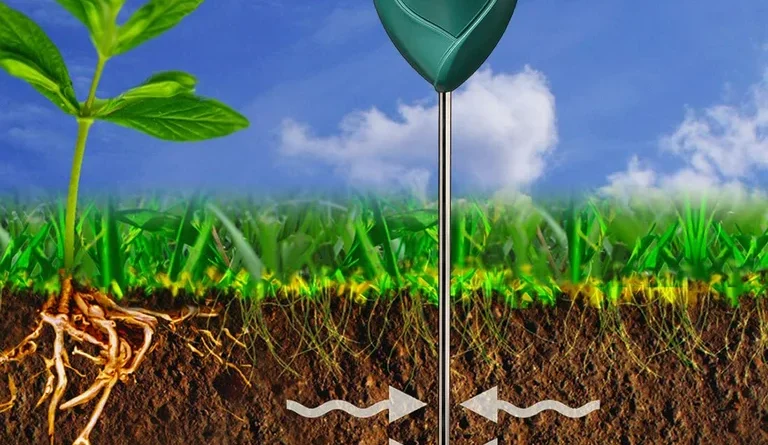Soil Moisture Sensor 24
Soil Moisture Sensor
In agriculture, environmental monitoring, and landscaping, soil moisture sensors are vital instruments. They provide effective irrigation control, ideal plant growth, and water resource conservation by providing real-time data on the moisture content of the soil. For precise and ongoing soil moisture level monitoring, these sensors provide an affordable and practical option.
In both agricultural and gardening situations, the moisture content of the soil is an important consideration. Sufficient levels of soil moisture are critical for plant growth because they promote nutrient uptake and control plant temperature through transpiration and other mechanisms. The use of soil moisture sensors is essential for efficiently monitoring and controlling soil moisture levels, which promotes healthy plant growth and appropriate watering.

Using soil moisture sensors with extended coverage can have a major positive impact on both cost and efficiency for larger agricultural operations or expansive landscapes. Farmers and land managers can streamline their monitoring efforts and make better decisions about irrigation and soil management techniques by lowering the number of sensors required to monitor a particular area.
Furthermore, new developments in sensor technology—like data aggregation and wireless connectivity—have made it possible to include a number of sensors in extensive monitoring networks. Large tracts of land can be covered by these networks, which offer comprehensive insights into the dynamics of soil moisture over whole fields or landscapes.
Follow our Digiknowledge.co.in page for the latest updates about bikes, cars, sports, lifestyle, and many more.
How do soil moisture sensors operate?
Numerous principles, such as capacitance, tensiometry, time domain reflectometry (TDR), and frequency domain reflectometry (FDR), underpin the operation of soil moisture sensors. The dielectric constant of the soil, which is correlated with its moisture content, is measured via capacitance-based sensors. Tensiometers measure the force needed to remove water from the soil in order to determine the moisture tension in the soil. By analyzing variations in wave propagation time or frequency, TDR and FDR sensors employ electromagnetic waves to determine the moisture content of the soil.
Uses for Soil Moisture Sensors
Precision Irrigation Management: By giving real-time information on soil moisture levels, soil moisture sensors allow for precise irrigation scheduling. This minimizes water waste and maximizes irrigation efficiency by ensuring that plants receive the right amount of water.
Optimal Plant Growth: Sufficient soil moisture content is essential for the best possible plant growth and development. Growers may monitor soil moisture levels to make sure plants receive enough water for transpiration, photosynthesis, and nutrient uptake, which will result in healthier and more productive harvests.
Temperature Regulation: Through mechanisms like transpiration, water is essential for controlling the temperature of plants. Sufficient moisture in the soil aids in maintaining the ideal temperature for plants, avoiding heat stress in hot weather, and encouraging growth.
Root Development: By giving plants the hydration and aeration they require, moist soil conditions encourage strong root growth. In order to promote stronger and more extensive root systems, soil moisture sensors aid in maintaining soil moisture levels within the ideal range for root growth.
Preventing Anaerobic Conditions: High soil moisture content can result in anaerobic conditions, which favor the growth of dangerous soil pathogens by limiting the availability of oxygen. Growers can reduce the chance of soilborne infections and stop the formation of anaerobic conditions by keeping an eye on the moisture content of their soil.
What is a soil moisture sensor?
Soil moisture sensors represent a pivotal advancement in agricultural monitoring, offering a convenient means to measure the volumetric content of water within soil. Unlike traditional gravimetric methods that entail drying and weighing soil samples, soil moisture sensors provide direct measurements, making them indispensable for modern farming practices
How much area can a soil moisture sensor cover?
As a matter of fact, soil moisture sensors are available in a range of shapes and sizes to suit diverse land management scenarios. There are versions of sensors that can cover bigger regions, even though many are made to efficiently cover 1-2 acres. Larger detection ranges or networked systems that enable greater coverage are common characteristics of these sensors.
How sensitive are soil moisture sensors?
As they can measure the full range of volumetric water content (VWC) in soil, from absolutely dry circumstances to being completely submerged in water, soil moisture sensors do in fact show extraordinary sensitivity. The sensors’ broad dynamic range makes them highly desirable instruments for research, environmental, and agricultural applications as they yield accurate and dependable data at different soil moisture levels.
Can nearby objects affect an SMS reading?
Accurate readings depend on the sensing volume of soil moisture sensors being clear of impediments like pebbles or roots. Measurements may be skewed or read lower than the true soil moisture content when the sensor’s probes come into contact with physical obstacles in the soil.
The sensor’s capacity to properly make contact with the surrounding soil particles and penetrate the soil may be hampered by roots, pebbles, or other debris. The electrical or electromagnetic impulses that the sensor uses to monitor soil moisture are interfered with by this interference, which causes readings to fluctuate or become inaccurate.




